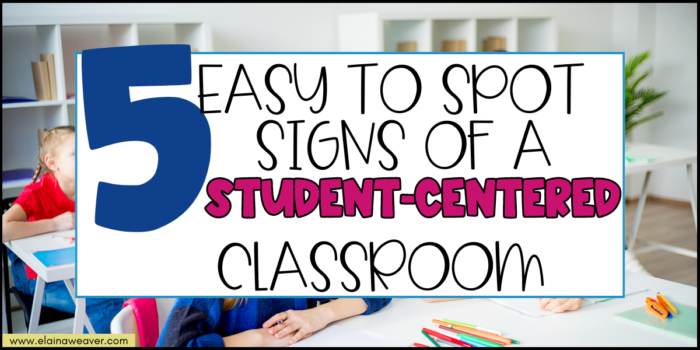Would you recognize a student-centered classroom if you saw it in person? Do you have a student-centered classroom?
If you are like me, sometimes we tend to overthink terms like this and what they mean. I would be willing to bet that there are aspects of your classroom that are student-centered.

Do students feel comfortable in your classroom to make mistakes and learn from one another? Are they talking about their learning or are you doing all the talking?
Those questions are simply the tip of the iceberg when it comes to a student-centered classroom.
Student Centered Learning Environment
As you know, the environment of your class plays a significant role in student learning. We want our classrooms to be inviting. They often show off our personality and our teaching style.
Does your classroom environment lend itself to students talking to each other? Does it create opportunities for students to collaborate and cheer each other on?
Let me share with you three things you will find in my classroom that help create a student-centered learning environment.
1. Students in Groups
Group seating seems like such an obvious one. Arranging your desk so that students sit with a partner or in groups opens up opportunities for collaboration, sharing, and supporting one another. When students work in or even just sit in a group they have the chance to gain an abundance of life skills. Personally, I love to watch their different personalities struggle and figure out how to come together to work in harmony. They learn to use each other as a resource and stop relying so heavily on you, the teacher. It’s a beautiful thing. My students are arranged in groups of four which I have found to be the perfect group size for me.
2. Students Chatting
I’m not talking about those random conversations that disrupt our classrooms. I’m talking about students chatting about their learning. The more students talk about what they are learning, the deeper their understanding goes. These academic conversations are critical for those students whose first language is not English. When students start talking about their learning, they begin taking ownership of their own learning. They start asking more questions and pushing themselves to go even further. And I can promise you the joy you will feel hearing your students talk about math is worth it.

3. Students Tracking Data
Speaking of students taking ownership of their learning, having them track data is one way I do this in my classroom. For each test, each of my classes set a goal of what we want our class average to be. When determining this goal we talk about how we want to push ourselves and not choose a goal that is too low. But at the same time a class average of 100% is not realistic.
If the class meets their goal, they earn a reward they chose. Doing this brings a sense of community to our classroom. They encourage one another and help each other study. We have a poster for each class where they record their goal and then graph their actual average.
Activities for Student Centered Learning
Setting up the environment is just part of how I create a student-centered classroom. Beyond that I try to be purposeful in the activities I choose for my students. I want activities that encourage them to take ownership of their learning.
And I’ll go ahead and say it.
I don’t grade everything. We have conversations all throughout the year about the purpose of the activities we do in class. They are not to earn a grade. Even the ones that are graded serve a bigger purpose. The activities are meant for students to practice and grow as mathematicians.
4. Self Checking Activities
One of my favorite ways for students to see the purpose of practicing is through self-checking activities. Students receive immediate feedback and can work until they have the correct answer. Obviously that results in nearly every student making a 100%, but again a grade is not the purpose. These types of assignments are rarely graded in my classroom. Instead, they are used to help students learn from their mistakes and persevere through the struggle. It’s about their learning.
5. Choice Boards
I would be remiss if I ended this post without sharing about Choice Boards. I swear they are my love language. Honestly, can you imagine your students choosing to practice Math? Because that is what happens when you start using choice boards in your classroom. When students have a choice of what they practice or how they practice, it gives them a chance to be reflective. They start thinking about their areas of struggle and how they learn.
Learn More…
Free Choice Board Template to Get Started
Even More Choice Board Templates

